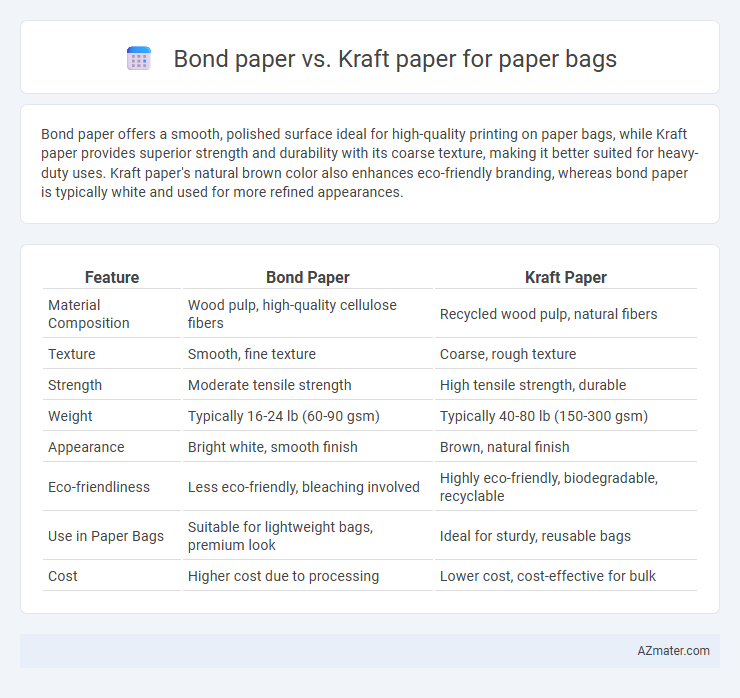Bond paper offers a smooth, polished surface ideal for high-quality printing on paper bags, while Kraft paper provides superior strength and durability with its coarse texture, making it better suited for heavy-duty uses. Kraft paper's natural brown color also enhances eco-friendly branding, whereas bond paper is typically white and used for more refined appearances.
Table of Comparison
| Feature | Bond Paper | Kraft Paper |
|---|---|---|
| Material Composition | Wood pulp, high-quality cellulose fibers | Recycled wood pulp, natural fibers |
| Texture | Smooth, fine texture | Coarse, rough texture |
| Strength | Moderate tensile strength | High tensile strength, durable |
| Weight | Typically 16-24 lb (60-90 gsm) | Typically 40-80 lb (150-300 gsm) |
| Appearance | Bright white, smooth finish | Brown, natural finish |
| Eco-friendliness | Less eco-friendly, bleaching involved | Highly eco-friendly, biodegradable, recyclable |
| Use in Paper Bags | Suitable for lightweight bags, premium look | Ideal for sturdy, reusable bags |
| Cost | Higher cost due to processing | Lower cost, cost-effective for bulk |
Introduction to Paper Bag Materials
Bond paper and Kraft paper serve distinct roles in the production of paper bags, each offering unique properties suited to specific applications. Bond paper is smooth, lightweight, and ideal for printing detailed graphics, making it popular for promotional or retail bags requiring a refined appearance. Kraft paper is stronger and more durable, with a natural brown color and higher tear resistance, commonly used for grocery bags and heavy-duty packaging due to its sustainability and robust structure.
What is Bond Paper?
Bond paper is a high-quality, durable paper commonly used for documents and stationery, characterized by its smooth texture and strength. It is made from cotton or cotton-blend fibers, providing excellent resistance to tearing and aging, making it ideal for printing and writing on paper bags requiring a refined appearance. Compared to kraft paper, bond paper offers a brighter and more polished finish, suitable for premium paper bags used in retail or gifting applications.
What is Kraft Paper?
Kraft paper is a strong, durable paper made from wood pulp through the Kraft process, known for its high tear resistance and natural brown color, making it ideal for paper bags that require sturdiness and eco-friendliness. Unlike bond paper, which is smoother and primarily used for printing, Kraft paper offers superior strength and moisture resistance, often used in packaging and shopping bags. Its unbleached, recyclable nature supports sustainable practices, distinguishing it as a preferred material in the production of heavy-duty paper bags.
Strength and Durability Comparison
Bond paper, typically made from high-quality wood pulp, offers smooth texture and moderate strength ideal for lightweight paper bags, but it lacks the durability needed for heavy-duty use. Kraft paper, created through the kraft process, provides superior tensile strength and tear resistance, making it highly durable and better suited for carrying heavier items in paper bags. The enhanced fiber structure and higher tear resistance of kraft paper ensure longer-lasting durability and robustness compared to bond paper in paper bag applications.
Printability and Surface Finish
Bond paper offers a smooth surface finish ideal for high-quality printing, resulting in crisp, vibrant graphics on paper bags. Kraft paper provides a rougher texture with lower printability, often resulting in muted colors and less detail in printed designs. For paper bags requiring detailed branding and sharp images, bond paper is the superior choice, while kraft paper suits rustic or natural-themed bags with simpler print needs.
Environmental Impact and Sustainability
Bond paper offers a smoother finish and higher recyclability due to its chemical composition, making it an eco-friendly choice for paper bags when sourced from sustainably managed forests. Kraft paper, made from unbleached wood pulp through the sulfate process, provides superior strength and biodegradability, enhancing its environmental sustainability by breaking down more quickly in natural settings. Both materials contribute to reducing plastic waste, but kraft paper's lower chemical processing and higher durability make it a preferred option for sustainable, reusable paper bags.
Cost Analysis: Bond Paper vs Kraft Paper
Bond paper typically costs more than kraft paper due to its refined texture and brightness, making it ideal for premium-quality paper bags. Kraft paper offers a more economical option, with lower production costs stemming from its coarse fibers and less processing, which suits heavy-duty, eco-friendly packaging needs. Businesses focusing on cost-efficiency and sustainability often prefer kraft paper bags to minimize expenses without compromising durability.
Common Uses in Paper Bag Production
Bond paper and Kraft paper serve distinct roles in paper bag production, with Kraft paper primarily used for heavy-duty bags due to its high durability and tear resistance, ideal for grocery and retail packaging. Bond paper is favored for lightweight, custom-printed bags, offering a smooth surface perfect for detailed branding and promotional uses. Both materials are chosen based on the bag's purpose, balancing strength and print quality to meet specific packaging needs.
Aesthetic Appeal and Branding Options
Bond paper offers a smooth, clean surface ideal for high-quality printing, enhancing the aesthetic appeal of paper bags with sharp logos and vibrant colors. Kraft paper, with its natural brown texture, provides a rustic and eco-friendly look that appeals to environmentally conscious brands seeking a handcrafted, authentic image. Both materials allow versatile branding options, but bond paper excels in detailed, colorful designs while kraft paper supports minimalist, sustainable branding narratives.
Choosing the Best Paper for Your Bags
Choosing the best paper for your bags depends on the desired durability and aesthetic appeal. Bond paper offers a smooth finish and high print quality, making it ideal for stylish retail packaging, while Kraft paper provides superior strength and eco-friendly appeal suitable for heavy-duty or natural-themed bags. Evaluating the weight, tear resistance, and environmental impact of bond versus Kraft paper ensures the right balance between functionality and branding in your paper bag production.

Infographic: Bond paper vs Kraft paper for Paper Bag
 azmater.com
azmater.com